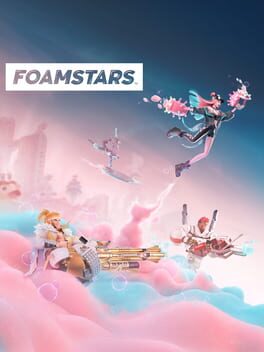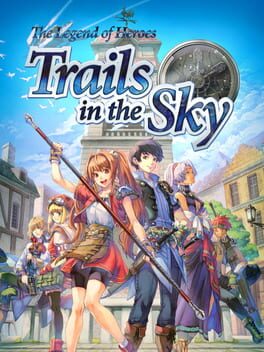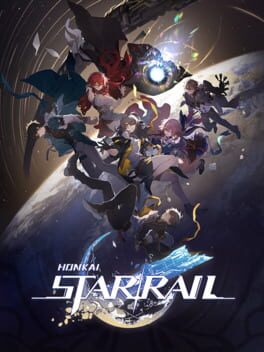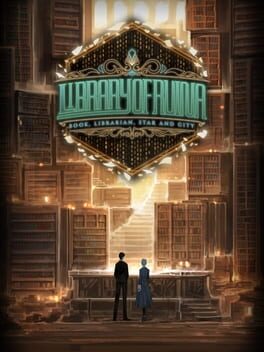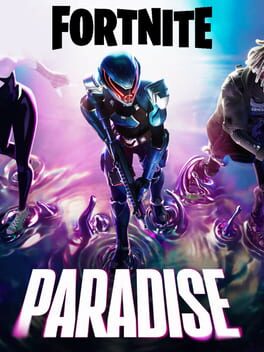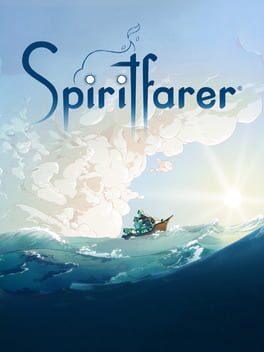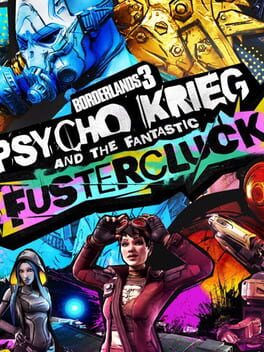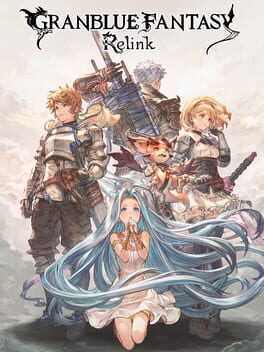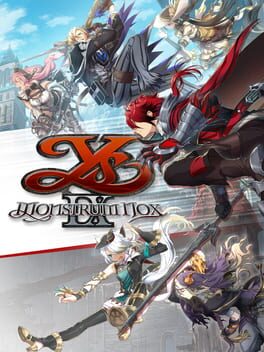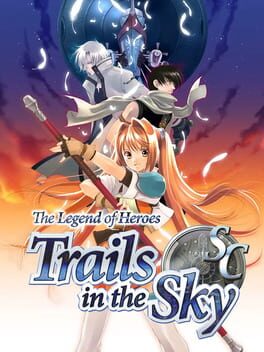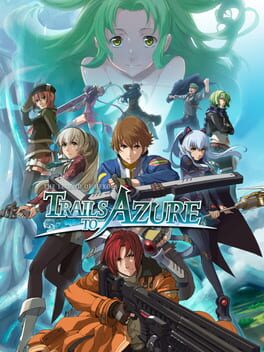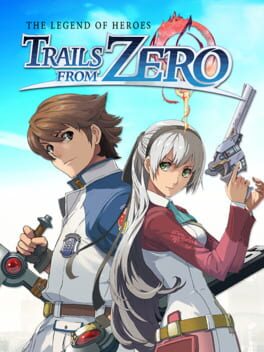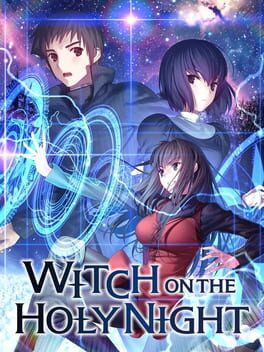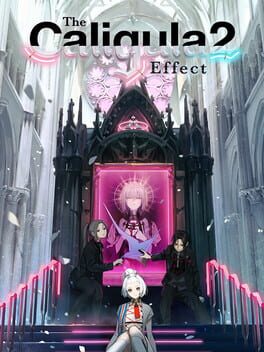19 reviews liked by Jod
Trails into Reverie, the 10th entry into the long running continuous narrative that is the Trails series and a title that aims to wrap up loose threads from the Crossbell and Erebonia arcs. In fact it's so important that you have at least played those games that NISA went out of their way to localise Trails from Zero and to Azure before getting Reverie localised. While it seems publishing issues holds things up in the West, Falcom did port all 4 of the Cold Steel titles onto Switch in Japan. Both of those insinuate just how important it is to have at least played the Crossbell and Erebonia games before Reverie and on top of that the in game novel from Cold Steel IV, 3 & 9, also plays a huge part in Reverie, leading to it getting included on the main menu of Reverie too, to allow players to catch up. All this to say that talking about elements of Reverie is near impossible without spoiling some elements from previous arcs so keep that in mind if you plan on reading this review for it. With that out of the way….. let's see how this Trail ends.
As usual it is always easier to go into the incremental changes in gameplay and what we have here is very much a culmination of the Cold Steel battle system in all its glory. Arcus Links, Brave Orders, and all that good stuff is back with one new major addition to the system - United Fronts. Cold Steel III first introduced these purple icons at the bottom right of your screen that allowed you to instantly break a foe before entering battle with them. Well now these Charges as they're called can be used in battle to unleash a United Front, where all of your active party members and reserve members combine to unleash a powerful group attack or heal. You can choose between an Art based or physical attack as well in these United Fronts, giving you options which is handy in case you don't have optimal set ups on your characters. With 50+ playable characters in the game, accessible throughout most of the game, sharing the same resources… yeah, unless you have a lot of patience to move your equipment about, you're probably gonna have moments where your characters aren't set up how you want and these United Fronts offer a good option in case you don't have healing set up properly or you're lacking a powerful arts attacker etc. With battles you have more options than ever and a near infinite set of possible character combinations and orbment sets to explore and it's all wrapped up in combat being the culmination of years of additions and improvements, leading to a very satisfying and engaging experience.
Falcom have also taken the opportunity to test out a new engine here, with it getting used for a few select cutscenes and wow, what a difference! You can tell when it gets pulled out because all of a sudden characters move much more fluidly, the camera is much more dynamic and the scenes are much more kinetic. I could live with the old stilted robotic scenes but when you see how much of a difference having that dynamic, kinetic action makes, gosh does it look fantastic.
Where Reverie mostly differs from previous Trails experiences is how it handles its story. Similar to Trails in the Sky the 3rd, it's an epilogue game to wrap up some loose ends and tease for the future but unlike Sky the 3rd, this game features a more traditional Trails style story outwith a Phantasma dungeon like set up with its new Trails to Walk system where the story follows 3 different protagonists in an intertwining story. We do lose the traditional Trails side quests but we still get to explore the world and revisit old areas as well as redone areas for a more traditional RPG experience compared to Sky the 3rd that was mostly focused on dungeon crawling.
Starting the game up you're thrown into a prologue section where the SSS are in the process of liberating Crossbell from the remaining EDF members who are disappointed with how Erebonia ended up after the Great War and are clinging onto Osborne's old ambitions. It's a great start to the game and helps further emphasise that even though the curse of Erebonia did influence people into craving war and conflict, that deep rooted desire was always there in some people and that ending the curse doesn't automatically stop all Erebonian’s from ever wanting conflict again. The SSS carry out their mission in Orchis Tower in style, including help from a lot of returning Crossbell based faces like Noel and Wazy who are so nice to see again after so long.
With SSS success, Crossbell is free again and prepares to celebrate its hard fought independence… only for a few familiar faces to gatecrash the event and reclaim Crossbell under the EDF and a man calling himself the Supreme Leader of the United Nation of Crossbell, proclaiming the lofty goal of uniting all of Zemuria. The SSS are soundly beaten by this man and Crossbellans watching the event lose hope, their heroes defeated and independence snatched from them yet again, they give into despair and believe in the United Nation dream being sold to them.
The prologue kicks off the events that split into the three storylines that the Trails to Walk system follows. In your first playthrough you'll experience each act 1 in a set order and that's the order I'll be going through them.
First up is Lloyd's route which follows on directly from the prologue events. Having recovered from the events there thanks to Rixia looking after him, it's up to him to find where the rest of the SSS have dispersed to and once again get over the barrier to Crossbell’s independence. The core plot of Lloyd’s route does go through similar elements as Azure did and Crossbell's fight for independence has been something that has been going on for many a game but I think that is oversimplifiing and underselling the story here. Now that we're free from the complex Cold Steel story that was trying to carry and weave together a few too many plot points and way too many characters to give satisfying arcs to, Reverie returns to what I'd say Trails is so good at - compelling character driven stories. While Lloyd's route does cover similar beats to Azure, the core character drama of the SSS having lost sight of what they were originally for is what makes this route so good. The exploration of how people's weight of expectations and idolising of you can cause you to lose sight of yourself and lose your way. For Lloyd he was a simple detective who supported those in need and in turn the people of Crossbell supported the SSS, they relied on each other. 2 years of Imperial rule however had changed the dynamic to where Crossbellans felt they needed a hero to save them and they looked to the SSS to be those heroes. It's such an interesting look on how people's emotions can have an effect on each other and we'll be going into that more with the other two routes, don't you worry.
For those that have played the Crossbell games, Lloyd’s route offers a lot of satisfying catching up with characters who we haven't seen in a while, as well as seeing just about all of Crossbell fully modelled in a 3D environment to scale having had bits and pieces done throughout the Cold Steel games. Seeing not only characters like Wazy and Noel but also Chief Sergei, Dudley, Zeit and Wald as well as locations like the Mainz Mining Village all back again after so long is a special treat for long-time Crossbell fans. That's what this route is mainly about really, giving Crossbell fans the closure they've been craving since Azure and it's done really well that it's hard to complain.
Our second route follows Rean, who after his heroics in stopping the Great Twilight, is taking the chance to relax at his home village of Ymir with a few members of new Class VII. The core plotline of his route is mainly about investigating the mysterious disappearance of the Courageous II, which was carrying the newly wed Olivert and Scherazard on it. Rean's route follows a Class VII style investigation of each area you visit, meeting people and learning about what's happening in the area, etc. Again, like how Lloyd's route followed Azure plot beats, those familiar with Cold Steel will find Rean's route familiar. However, being free from bonding events, meandering plotlines, and every single girl fawning over Rean, Rean's route feels pretty fresh. Being free from that stuff helps the writing feel a lot more focused and again, that means the character specific stuff gets to shine. For example Claire shows up early in Rean's route and she was a character I had a few issues with in Cold Steel IV but Reverie takes the opportunity to sit down with the character and actually explores how she feels. She and Rean have this heart to heart where she admits that she's throwing herself into her work because she's struggling with liking herself for what she's done. Rean is a parallel of sorts where he doesn't feel like he deserves happiness because of how he was the one who unleashed the Great Twilight. It's great stuff and something Cold Steel fumbled with a bit because of how much it was juggling with its main plot.
There's also Juna struggle with the news that Crossbell has been occupied again and she's trying to deal with it on her own because she doesn't want to be a burden to everyone else and Rean picks up on that, telling her that everyone wants to help her, only for her to point out he does the same thing and it leads to this great moment where Rean admits he has a problem and needs to work on it. Yeah it's something he's been struggling with for 4+ games now but Reverie actually takes the time to explore his issues properly and let him work through it and that is so appreciated as someone who goes through a similar thing.
As you may have picked up on by now, Rean's route explores how thinking about dealing with your problems yourself and being willing to sacrifice yourself affects the people you love in negative ways. We may think we're not burdening others by doing that but in reality our bonds carry our emotions to each other so bottling things up only causes pain and suffering to those worried about you and willing to help.
A few plot elements from the Cold Steel arc do reappear here and I was worried when I first saw them because I was at the point where I was done with them and thought we had moved past it but thankfully these elements are not used in a convoluted way and are handled a lot neater, keeping things simple.
This route is mostly about wrapping up Rean’s character arc so if that's up your alley then you'll find this to be a pretty satisfying route though I do understand for many, going through more Rean stuff for the fifth game in a row could be tiresome.
Finally we have the mysterious C route, focusing on new characters introduced through the 3 & 9 novel as well as a mysterious doll and of course our masked man donning the persona of the old Imperial Liberation Front’s main terrorist. The combination of characters in this route make for a fascinating quadlet, each one feeling like outcasts in a world that has shunned them.
C, while difficult to go into while avoiding spoilers on his true identity, is probably the best character in the game which I was not expecting going in. He has no qualms about using people to achieve his goals, happy to take on the mantle of villain, and has no regrets about the crimes he has committed. He walks a path in the shadows compared to previous Trails protagonists who have always shone bright, like the goody two shoes they are but my gosh, what a breath of fresh air that makes C. What's even better is watching his relationship with Lapis, the sentient doll that Swin and Nadia were tasked on delivering to him, develop and have a profound effect on him. C is very much a man who has lost his purpose in life, alone because he had no need for relationships and felt like his crimes had denied him from being allowed any relationships and then along comes this doll, with no idea on how the world works, no real sense of what makes a person good or bad or how someone's history weighs on them, and she just sees him for him. Lapis doesn't know what he's done, C is just C to her and that slowly has an effect on him to where his life finally gains a meaning again.
Lapis is on the other end of the scale. She's a doll with no memories and as such, she has no idea how she fits in this world and that comes with a heavy dose of existential dread. Nadia is very quick to treat her like a little sister, showing her around Heimdallr and treating her to food as the two form a bond. It's her dynamic with C that shines brightest though, just as she helps him discover his sense of self again, so too does he with her. He reuses her speech to him about how Lapis is Lapis and no one else can be Lapis Rosenberg. There's other fantastic moments with Lapis as her experiences with the Imperial Picnicking Front (as Nadia calls the group) shapes her view and allows her to make a definitive choice late on in the final battle.
Swin and Nadia are our 3 & 9 from the novel. Reading that is essential for understanding their backstory as two assassins who had escaped an organisation and killed the leader of it in doing so. This has meant their lives now have them constantly looking over their shoulder as they try to find somewhere they can belong and just be people instead of tools. The two make a great yin yang duo in traditional peak Trails dynamic writing. Swin is very much the reserved of the two, keeping an eye on Nadia while being dragged into her shenanigans. He provides the rational head and is the responsible one, always being on top of what he's getting involved in. Nadia is much more free spirited and will generally do what she wants. She has this wonderful dichotomy going on with this cute girl carrying a teddy bear look that hides the horrors she has suffered from being in the organisation. She's no frail little girl and there's an impactful scene where she very graphically describes how she would torture someone to gain information from them and it's quite terrifying imagining what a 13 year old girl has been through to know stuff like that. It's clear though that life in the organisation has traumatised her in ways as Swin is the only person she can feel comfortable enough around to sleep. Swin and Nadia make a fantastic duo, a pair of people who have through so much together at such a young age, working perfectly in sync together covering each other's weak points.
Character wise, C route offers what has been my favourite group of characters since the Crossbell games and story wise it's pretty strong too.
This route deals with C being gifted Lapis and hiring Swin and Nadia to help him achieve his goals. Part of that ends up including helping Lapis regain her memories and this route really shines when they take on the role of villains to push people like Rean and Class VII into the direction of the real issues at hand as they're much more well equipped for taking on the role of heroes. The core theme of finding your place in a world where you don't feel like you belong is the fantastic pillar of the route and it goes a long way into making it my favourite of the three.
Each route is split into 4 acts before everyone comes together for the finale and these stories are intertwined with one another where you'll be locked out of a route until another one catches up. Sometimes they directly overlap and you'll be jumping from doing a boss battle in one route before switching perspective and doing it in the other route, or you'll be progressing through a dungeon in one route before needing another route to work through a different dungeon connected to that one so that they can both open a door at the same time. It's really cool stuff and I haven't seen a game pull off a multiple route story quite with this level of interconnectivity between each route. The Trails to Walk system also lets you pause one route and jump into another whenever you want after a certain point and when you jump back to that route you paused, it's right from where you left off, no progress lost or anything. It's a brilliant system and when you have this many characters with so many different perspectives in the series, I can really appreciate the multiple route approach to the story telling.
As everyone comes together for the finale, the story wraps up in the spectacular way you're probably used to by now. The stakes get raised higher and higher and the finale explores some really cool ideas, using elements from both Azure and Cold Steel IV in a really satisfying way. There's really great moments as characters like Rean finally understand how taking on the burden themselves affects the people they love and there's this absolutely incredible scene between Lloyd and C with a line of dialogue that will probably stick with me forever. It's a fantastic end to one of the most well paced Trails stories to date.
Now it's time to get into the other side of Reverie, the part that borrows from Phantasma in Sky the 3rd - The True Reverie Corridor. Around act 2 of the story, characters start finding a shard of a purple mirror in their pocket and are whisked away to another plane called the True Reverie Corridor, a space set up to essentially allow you to level up your characters as the main story moves at a pace where some people will end up falling behind. The TRC has multiple stratums that are randomly generated dungeons and you get to use all the characters you've met up to that point in the story, as well as special guest characters, to build a party in whatever way you want to tackle these dungeons and level up your characters. But grinding on its own would be kinda boring, so the game incentivises you by rewarding you with Sealing Stones for taking on mini bosses and stuff. Returning from Sky the 3rd, these Sealing Stones come in multiple varieties. Silver offers random items, Red offers minigames, Blue offers Daydreams, and Gold offers new playable characters. The minigame assortment provides a nice break from the dungeon crawling and there's some fun stuff like a Magical Girl rail shooter and the return of Who Wants to be a Mirrannaire, a quiz about various Trails things.
Daydreams act much like the doors did in Sky the 3rd, where you'll get glimpses of events from the past and learn about stuff that happened off screen. While there isn't anything quite as hard hitting as Renne’s backstory, there's still plenty to enjoy here, like Olivert and Scherazard preparing for their wedding, Claire struggling with her family problems, Lechter trying to find his place in the world. A lot of good stuff to enjoy and a good variety of silly light-hearted ones as well as powerful emotional ones providing much needed character growth.
Throughout your time in the TRC, you'll find Trial Keys that can be used in the main hub area to unlock specific challenge battles for specific characters at specific levels. It does mean you'll have to do a little bit of level grinding if you want to fight all of these but you do get a reward of a better S-Craft for each character who partook in that battle.
These stratum levels unlock as you progress through the game up to around half of level 4 where something goes wrong with the TRC trying to shut down the space as it's no longer needed but events in the main story prevents that from happening. Instead a meaty post game of exploring the depths of TRC becomes available with even more Daydreams and characters to unlock, with some of these Daydreams even providing a glimpse into what's to come from the Calvard arc. The post game story continues on from the main game, linking in even more elements from Azure and nicely wraps up just about everything, even if all the talk about causality and stuff can be a little hard to follow at times.
While I absolutely love Reverie I do have a couple of minor gripes with it, mostly relating to playable characters and a few that have unfortunately been excluded. Mueller, despite being playable in Sky the 3rd and having a model to use in all of the Erebonia arc games, is for some reason not playable. Dudley was one of my favourite surprise party members from the Crossbell arc and he's got a new model for this game but he isn't playable. Kevin is unfortunately still MIA, not even getting a new model yet still being mentioned throughout. Kloe is another character who does have a model but is unavailable to fight. I feel like when you have 50+ playable characters then it's like, well what's wrong with throwing in one or two more y’know? Especially in the post game, where some of the playable characters choices are fun and a little bit out there, I think it would've been nice to have the ones that have models but aren't playable at least. It's a small gripe though and it's not like you're lacking from characters to pick from at least.
Now on the technical side of things, my stubbornness of playing things on Switch because it's my preferred platform did throw a handful more issues into the mix. The Switch has never been great at running Crossbell through the Cold Steel games, with obvious framerate dips, especially in the Harbor District area. So when you have scenes that take place in Crossbell but they decide to pack in 50+ character models hoo boy does that framerate start to crawl… and it's the same in later scenes outside of Crossbell when nearly every single playable character is amassed. Now luckily, aside from the general Crossbell dips, all of these egregious drops take place in cutscenes and not actual gameplay so if you can live with that, then the Switch port offers a mostly competent experience. I had one crash while shuffling through the characters in the main menu screen instead of the character select screen but aside from that, it was fine. Obviously the other platforms are recommended and you can pick your previous game choices at the start of this one so you aren't missing out on much if you do change platform choice for this game. The PS5 version even just gives you all the save data bonuses anyway!
Trails into Reverie is a return to peak form for the series. It manages to keep its story moving at a brisk pace throughout its three routes with a beautiful story whose themes line up throughout each route. Bringing together almost all of the gang from across Liberl, Crossbell, and Erebonia, Reverie gives them all one big send off with a smile, reminding us every step of the way that your existence does matter and you are more loved than you realise.
As usual it is always easier to go into the incremental changes in gameplay and what we have here is very much a culmination of the Cold Steel battle system in all its glory. Arcus Links, Brave Orders, and all that good stuff is back with one new major addition to the system - United Fronts. Cold Steel III first introduced these purple icons at the bottom right of your screen that allowed you to instantly break a foe before entering battle with them. Well now these Charges as they're called can be used in battle to unleash a United Front, where all of your active party members and reserve members combine to unleash a powerful group attack or heal. You can choose between an Art based or physical attack as well in these United Fronts, giving you options which is handy in case you don't have optimal set ups on your characters. With 50+ playable characters in the game, accessible throughout most of the game, sharing the same resources… yeah, unless you have a lot of patience to move your equipment about, you're probably gonna have moments where your characters aren't set up how you want and these United Fronts offer a good option in case you don't have healing set up properly or you're lacking a powerful arts attacker etc. With battles you have more options than ever and a near infinite set of possible character combinations and orbment sets to explore and it's all wrapped up in combat being the culmination of years of additions and improvements, leading to a very satisfying and engaging experience.
Falcom have also taken the opportunity to test out a new engine here, with it getting used for a few select cutscenes and wow, what a difference! You can tell when it gets pulled out because all of a sudden characters move much more fluidly, the camera is much more dynamic and the scenes are much more kinetic. I could live with the old stilted robotic scenes but when you see how much of a difference having that dynamic, kinetic action makes, gosh does it look fantastic.
Where Reverie mostly differs from previous Trails experiences is how it handles its story. Similar to Trails in the Sky the 3rd, it's an epilogue game to wrap up some loose ends and tease for the future but unlike Sky the 3rd, this game features a more traditional Trails style story outwith a Phantasma dungeon like set up with its new Trails to Walk system where the story follows 3 different protagonists in an intertwining story. We do lose the traditional Trails side quests but we still get to explore the world and revisit old areas as well as redone areas for a more traditional RPG experience compared to Sky the 3rd that was mostly focused on dungeon crawling.
Starting the game up you're thrown into a prologue section where the SSS are in the process of liberating Crossbell from the remaining EDF members who are disappointed with how Erebonia ended up after the Great War and are clinging onto Osborne's old ambitions. It's a great start to the game and helps further emphasise that even though the curse of Erebonia did influence people into craving war and conflict, that deep rooted desire was always there in some people and that ending the curse doesn't automatically stop all Erebonian’s from ever wanting conflict again. The SSS carry out their mission in Orchis Tower in style, including help from a lot of returning Crossbell based faces like Noel and Wazy who are so nice to see again after so long.
With SSS success, Crossbell is free again and prepares to celebrate its hard fought independence… only for a few familiar faces to gatecrash the event and reclaim Crossbell under the EDF and a man calling himself the Supreme Leader of the United Nation of Crossbell, proclaiming the lofty goal of uniting all of Zemuria. The SSS are soundly beaten by this man and Crossbellans watching the event lose hope, their heroes defeated and independence snatched from them yet again, they give into despair and believe in the United Nation dream being sold to them.
The prologue kicks off the events that split into the three storylines that the Trails to Walk system follows. In your first playthrough you'll experience each act 1 in a set order and that's the order I'll be going through them.
First up is Lloyd's route which follows on directly from the prologue events. Having recovered from the events there thanks to Rixia looking after him, it's up to him to find where the rest of the SSS have dispersed to and once again get over the barrier to Crossbell’s independence. The core plot of Lloyd’s route does go through similar elements as Azure did and Crossbell's fight for independence has been something that has been going on for many a game but I think that is oversimplifiing and underselling the story here. Now that we're free from the complex Cold Steel story that was trying to carry and weave together a few too many plot points and way too many characters to give satisfying arcs to, Reverie returns to what I'd say Trails is so good at - compelling character driven stories. While Lloyd's route does cover similar beats to Azure, the core character drama of the SSS having lost sight of what they were originally for is what makes this route so good. The exploration of how people's weight of expectations and idolising of you can cause you to lose sight of yourself and lose your way. For Lloyd he was a simple detective who supported those in need and in turn the people of Crossbell supported the SSS, they relied on each other. 2 years of Imperial rule however had changed the dynamic to where Crossbellans felt they needed a hero to save them and they looked to the SSS to be those heroes. It's such an interesting look on how people's emotions can have an effect on each other and we'll be going into that more with the other two routes, don't you worry.
For those that have played the Crossbell games, Lloyd’s route offers a lot of satisfying catching up with characters who we haven't seen in a while, as well as seeing just about all of Crossbell fully modelled in a 3D environment to scale having had bits and pieces done throughout the Cold Steel games. Seeing not only characters like Wazy and Noel but also Chief Sergei, Dudley, Zeit and Wald as well as locations like the Mainz Mining Village all back again after so long is a special treat for long-time Crossbell fans. That's what this route is mainly about really, giving Crossbell fans the closure they've been craving since Azure and it's done really well that it's hard to complain.
Our second route follows Rean, who after his heroics in stopping the Great Twilight, is taking the chance to relax at his home village of Ymir with a few members of new Class VII. The core plotline of his route is mainly about investigating the mysterious disappearance of the Courageous II, which was carrying the newly wed Olivert and Scherazard on it. Rean's route follows a Class VII style investigation of each area you visit, meeting people and learning about what's happening in the area, etc. Again, like how Lloyd's route followed Azure plot beats, those familiar with Cold Steel will find Rean's route familiar. However, being free from bonding events, meandering plotlines, and every single girl fawning over Rean, Rean's route feels pretty fresh. Being free from that stuff helps the writing feel a lot more focused and again, that means the character specific stuff gets to shine. For example Claire shows up early in Rean's route and she was a character I had a few issues with in Cold Steel IV but Reverie takes the opportunity to sit down with the character and actually explores how she feels. She and Rean have this heart to heart where she admits that she's throwing herself into her work because she's struggling with liking herself for what she's done. Rean is a parallel of sorts where he doesn't feel like he deserves happiness because of how he was the one who unleashed the Great Twilight. It's great stuff and something Cold Steel fumbled with a bit because of how much it was juggling with its main plot.
There's also Juna struggle with the news that Crossbell has been occupied again and she's trying to deal with it on her own because she doesn't want to be a burden to everyone else and Rean picks up on that, telling her that everyone wants to help her, only for her to point out he does the same thing and it leads to this great moment where Rean admits he has a problem and needs to work on it. Yeah it's something he's been struggling with for 4+ games now but Reverie actually takes the time to explore his issues properly and let him work through it and that is so appreciated as someone who goes through a similar thing.
As you may have picked up on by now, Rean's route explores how thinking about dealing with your problems yourself and being willing to sacrifice yourself affects the people you love in negative ways. We may think we're not burdening others by doing that but in reality our bonds carry our emotions to each other so bottling things up only causes pain and suffering to those worried about you and willing to help.
A few plot elements from the Cold Steel arc do reappear here and I was worried when I first saw them because I was at the point where I was done with them and thought we had moved past it but thankfully these elements are not used in a convoluted way and are handled a lot neater, keeping things simple.
This route is mostly about wrapping up Rean’s character arc so if that's up your alley then you'll find this to be a pretty satisfying route though I do understand for many, going through more Rean stuff for the fifth game in a row could be tiresome.
Finally we have the mysterious C route, focusing on new characters introduced through the 3 & 9 novel as well as a mysterious doll and of course our masked man donning the persona of the old Imperial Liberation Front’s main terrorist. The combination of characters in this route make for a fascinating quadlet, each one feeling like outcasts in a world that has shunned them.
C, while difficult to go into while avoiding spoilers on his true identity, is probably the best character in the game which I was not expecting going in. He has no qualms about using people to achieve his goals, happy to take on the mantle of villain, and has no regrets about the crimes he has committed. He walks a path in the shadows compared to previous Trails protagonists who have always shone bright, like the goody two shoes they are but my gosh, what a breath of fresh air that makes C. What's even better is watching his relationship with Lapis, the sentient doll that Swin and Nadia were tasked on delivering to him, develop and have a profound effect on him. C is very much a man who has lost his purpose in life, alone because he had no need for relationships and felt like his crimes had denied him from being allowed any relationships and then along comes this doll, with no idea on how the world works, no real sense of what makes a person good or bad or how someone's history weighs on them, and she just sees him for him. Lapis doesn't know what he's done, C is just C to her and that slowly has an effect on him to where his life finally gains a meaning again.
Lapis is on the other end of the scale. She's a doll with no memories and as such, she has no idea how she fits in this world and that comes with a heavy dose of existential dread. Nadia is very quick to treat her like a little sister, showing her around Heimdallr and treating her to food as the two form a bond. It's her dynamic with C that shines brightest though, just as she helps him discover his sense of self again, so too does he with her. He reuses her speech to him about how Lapis is Lapis and no one else can be Lapis Rosenberg. There's other fantastic moments with Lapis as her experiences with the Imperial Picnicking Front (as Nadia calls the group) shapes her view and allows her to make a definitive choice late on in the final battle.
Swin and Nadia are our 3 & 9 from the novel. Reading that is essential for understanding their backstory as two assassins who had escaped an organisation and killed the leader of it in doing so. This has meant their lives now have them constantly looking over their shoulder as they try to find somewhere they can belong and just be people instead of tools. The two make a great yin yang duo in traditional peak Trails dynamic writing. Swin is very much the reserved of the two, keeping an eye on Nadia while being dragged into her shenanigans. He provides the rational head and is the responsible one, always being on top of what he's getting involved in. Nadia is much more free spirited and will generally do what she wants. She has this wonderful dichotomy going on with this cute girl carrying a teddy bear look that hides the horrors she has suffered from being in the organisation. She's no frail little girl and there's an impactful scene where she very graphically describes how she would torture someone to gain information from them and it's quite terrifying imagining what a 13 year old girl has been through to know stuff like that. It's clear though that life in the organisation has traumatised her in ways as Swin is the only person she can feel comfortable enough around to sleep. Swin and Nadia make a fantastic duo, a pair of people who have through so much together at such a young age, working perfectly in sync together covering each other's weak points.
Character wise, C route offers what has been my favourite group of characters since the Crossbell games and story wise it's pretty strong too.
This route deals with C being gifted Lapis and hiring Swin and Nadia to help him achieve his goals. Part of that ends up including helping Lapis regain her memories and this route really shines when they take on the role of villains to push people like Rean and Class VII into the direction of the real issues at hand as they're much more well equipped for taking on the role of heroes. The core theme of finding your place in a world where you don't feel like you belong is the fantastic pillar of the route and it goes a long way into making it my favourite of the three.
Each route is split into 4 acts before everyone comes together for the finale and these stories are intertwined with one another where you'll be locked out of a route until another one catches up. Sometimes they directly overlap and you'll be jumping from doing a boss battle in one route before switching perspective and doing it in the other route, or you'll be progressing through a dungeon in one route before needing another route to work through a different dungeon connected to that one so that they can both open a door at the same time. It's really cool stuff and I haven't seen a game pull off a multiple route story quite with this level of interconnectivity between each route. The Trails to Walk system also lets you pause one route and jump into another whenever you want after a certain point and when you jump back to that route you paused, it's right from where you left off, no progress lost or anything. It's a brilliant system and when you have this many characters with so many different perspectives in the series, I can really appreciate the multiple route approach to the story telling.
As everyone comes together for the finale, the story wraps up in the spectacular way you're probably used to by now. The stakes get raised higher and higher and the finale explores some really cool ideas, using elements from both Azure and Cold Steel IV in a really satisfying way. There's really great moments as characters like Rean finally understand how taking on the burden themselves affects the people they love and there's this absolutely incredible scene between Lloyd and C with a line of dialogue that will probably stick with me forever. It's a fantastic end to one of the most well paced Trails stories to date.
Now it's time to get into the other side of Reverie, the part that borrows from Phantasma in Sky the 3rd - The True Reverie Corridor. Around act 2 of the story, characters start finding a shard of a purple mirror in their pocket and are whisked away to another plane called the True Reverie Corridor, a space set up to essentially allow you to level up your characters as the main story moves at a pace where some people will end up falling behind. The TRC has multiple stratums that are randomly generated dungeons and you get to use all the characters you've met up to that point in the story, as well as special guest characters, to build a party in whatever way you want to tackle these dungeons and level up your characters. But grinding on its own would be kinda boring, so the game incentivises you by rewarding you with Sealing Stones for taking on mini bosses and stuff. Returning from Sky the 3rd, these Sealing Stones come in multiple varieties. Silver offers random items, Red offers minigames, Blue offers Daydreams, and Gold offers new playable characters. The minigame assortment provides a nice break from the dungeon crawling and there's some fun stuff like a Magical Girl rail shooter and the return of Who Wants to be a Mirrannaire, a quiz about various Trails things.
Daydreams act much like the doors did in Sky the 3rd, where you'll get glimpses of events from the past and learn about stuff that happened off screen. While there isn't anything quite as hard hitting as Renne’s backstory, there's still plenty to enjoy here, like Olivert and Scherazard preparing for their wedding, Claire struggling with her family problems, Lechter trying to find his place in the world. A lot of good stuff to enjoy and a good variety of silly light-hearted ones as well as powerful emotional ones providing much needed character growth.
Throughout your time in the TRC, you'll find Trial Keys that can be used in the main hub area to unlock specific challenge battles for specific characters at specific levels. It does mean you'll have to do a little bit of level grinding if you want to fight all of these but you do get a reward of a better S-Craft for each character who partook in that battle.
These stratum levels unlock as you progress through the game up to around half of level 4 where something goes wrong with the TRC trying to shut down the space as it's no longer needed but events in the main story prevents that from happening. Instead a meaty post game of exploring the depths of TRC becomes available with even more Daydreams and characters to unlock, with some of these Daydreams even providing a glimpse into what's to come from the Calvard arc. The post game story continues on from the main game, linking in even more elements from Azure and nicely wraps up just about everything, even if all the talk about causality and stuff can be a little hard to follow at times.
While I absolutely love Reverie I do have a couple of minor gripes with it, mostly relating to playable characters and a few that have unfortunately been excluded. Mueller, despite being playable in Sky the 3rd and having a model to use in all of the Erebonia arc games, is for some reason not playable. Dudley was one of my favourite surprise party members from the Crossbell arc and he's got a new model for this game but he isn't playable. Kevin is unfortunately still MIA, not even getting a new model yet still being mentioned throughout. Kloe is another character who does have a model but is unavailable to fight. I feel like when you have 50+ playable characters then it's like, well what's wrong with throwing in one or two more y’know? Especially in the post game, where some of the playable characters choices are fun and a little bit out there, I think it would've been nice to have the ones that have models but aren't playable at least. It's a small gripe though and it's not like you're lacking from characters to pick from at least.
Now on the technical side of things, my stubbornness of playing things on Switch because it's my preferred platform did throw a handful more issues into the mix. The Switch has never been great at running Crossbell through the Cold Steel games, with obvious framerate dips, especially in the Harbor District area. So when you have scenes that take place in Crossbell but they decide to pack in 50+ character models hoo boy does that framerate start to crawl… and it's the same in later scenes outside of Crossbell when nearly every single playable character is amassed. Now luckily, aside from the general Crossbell dips, all of these egregious drops take place in cutscenes and not actual gameplay so if you can live with that, then the Switch port offers a mostly competent experience. I had one crash while shuffling through the characters in the main menu screen instead of the character select screen but aside from that, it was fine. Obviously the other platforms are recommended and you can pick your previous game choices at the start of this one so you aren't missing out on much if you do change platform choice for this game. The PS5 version even just gives you all the save data bonuses anyway!
Trails into Reverie is a return to peak form for the series. It manages to keep its story moving at a brisk pace throughout its three routes with a beautiful story whose themes line up throughout each route. Bringing together almost all of the gang from across Liberl, Crossbell, and Erebonia, Reverie gives them all one big send off with a smile, reminding us every step of the way that your existence does matter and you are more loved than you realise.
Foamstars
2024
A soulless, corporate cash-grab that not only fails in every regard, but especially fails to take your money.
I won’t lie, the game’s aesthetics and its music are phenomenal, and were the two things that initially drew me to it (that, and receiving this game for free from PS+). Unfortunately, those are the only compliments I have for the game. The map design is boring, character designs are generic, gameplay is uninteresting and disengaging, and there is absolutely nothing to feel any attachment towards. The reason why games like Overwatch, Apex, Splatoon, and hell — even Fortnite — are all enjoyable, aside from their addictive gameplay loop, is that they all have stories and characters that people grow attached to. People engage with them beyond the confines of the game because they love the worlds and narratives built from the characters.
Foamstars has none of that.
Foamstars has a narcissistic main character with some of the worst voice acting I’ve heard in a minute, along with a basic cast of characters that have nothing going for them. Nada. Their depth is essentially “hey this is their gender and their style of clothes!” Cool, I guess. You know what Overwatch has? A cringefail gorilla scientist who’s best friend is a temporally-unstable British lesbian and several people who won’t call him back. I’m gonna go play that instead, thanks.
Anyways, moral of the story is you’d be better off playing anything else. Literally anything. Go outside and play with sticks and rocks and I can guarantee you that you’ll have more fun with that than with this game.
I won’t lie, the game’s aesthetics and its music are phenomenal, and were the two things that initially drew me to it (that, and receiving this game for free from PS+). Unfortunately, those are the only compliments I have for the game. The map design is boring, character designs are generic, gameplay is uninteresting and disengaging, and there is absolutely nothing to feel any attachment towards. The reason why games like Overwatch, Apex, Splatoon, and hell — even Fortnite — are all enjoyable, aside from their addictive gameplay loop, is that they all have stories and characters that people grow attached to. People engage with them beyond the confines of the game because they love the worlds and narratives built from the characters.
Foamstars has none of that.
Foamstars has a narcissistic main character with some of the worst voice acting I’ve heard in a minute, along with a basic cast of characters that have nothing going for them. Nada. Their depth is essentially “hey this is their gender and their style of clothes!” Cool, I guess. You know what Overwatch has? A cringefail gorilla scientist who’s best friend is a temporally-unstable British lesbian and several people who won’t call him back. I’m gonna go play that instead, thanks.
Anyways, moral of the story is you’d be better off playing anything else. Literally anything. Go outside and play with sticks and rocks and I can guarantee you that you’ll have more fun with that than with this game.
It's rare for me to get into a series or a specific subset of a series and play through the games in order from the beginning. My only knowledge of the Trails/Kiseki series before picking up Trails in the Sky was of the character Nadia who had intrigued me towards the series and the novel 3 & 9 which a friend recommended to me and it sold me on getting into the series properly. So without any real knowledge of the series played like and without modern expectations from recent titles colouring my viewpoint, I began my journey into the Trails/Kiseki series with The Legend of Heroes: Trails in the Sky.
Trails in the Sky begins by introducing us to its charming protagonist Estelle Bright as her father brings home an mysterious injured young boy called Joshua who has little recollection of what happened to him at this point. There's no time wasted in presenting what a fun character Estelle is as she quickly demonstrates how rash and excitable she is by making sure Joshua gets rest, and throwing in witty remarks. The game uses wonderfully cute chibi models similar in style to the Golden Sun series which I adore so much. Dialogue boxes have well drawn 2D character portraits that have an excellent range of emotions shown off to further emphasise how a character is feeling in that moment. The game is adorable and it uses the combination of character models and portraits to detail its scenes very well.
After a timeskip of a few years we're reacquainted with the Bright family, seeing how well Joshua has fitted in and how close the family are. From here the real story loop begins as Estelle and Joshua decide to follow in their father's, Cassius Bright, footsteps and become Bracers, people who take on requests to help those in need and help maintain peace in the nation of Liberl with help of the army when needed. The story is very much focused on Estelle and Joshua and their quest to become full fledged Bracers and a good chunk of it is very cosy and heartwarming as they overcome the hardships they face along the way. It's what many would consider a slow burn, it does take a while to start getting into the big plot points and revelations but I think it's all the better for that. The game takes its time, making sure you get to know Estelle and Joshua, the world they live in and giving you the time to get attached to them so that the stuff that happens by the end truly impacts you. You go around visiting every city in Liberl, taking on missions from each guild, getting to know the citizens with the additional party members being rotated out from place to place. It's great because it gives you so much time to fall in love with its cast while keeping focus on Estelle and Joshua. Party members like Olivier and Tita get to shine in the chapters they're used in and because you have to use every character, you grow attached to their fighting styles and their personalities instead of benching newcomers because you're already taken with your current setup. Your travels see you meeting many people who Cassius has had an impact on and it gives a real sense of just how powerful this man is and how much he has done despite Estelle being unaware and seeing him as just her goofy dad. The fact that for the main story beats Estelle and Joshua often require help from more senior people really helps sell that they're junior bracers in training and as powerful as they are, they still have a long way to go to start solving missions on their own like Agate or Cassius. And I love that side quests are tied to the guilds! Doing sidequests gives you Bracer points which increase your rank so while you do a few simple ones like defeating certain monsters, you want to do them because you want to see Estelle and Joshua climb up the Bracer ranking, it's really neat. Unfortunately sidequests are time limited due to the structure of the game and it can be easy to miss some which is a shame. Everything is very well set up though story wise and they do an excellent job pulling you in.
While on the surface the story takes its time to get going, the game does a good job at adding intrigue to the seemingly simple scenarios that play out. Yeah you're stopping petty bandits but there's many signs of bigger things at play to keep you intrigued. By the time you get to the end a lot of things are tied together but then there's so many revelations that leave you excited for the next instalment.
As mentioned throughout so far, Estelle and Joshua are the stars of the show. The two perfectly compliment each other, she's the sun to his moon, a true yin and yang pair. Estelle is this bright cheerful character, bringing light to everyone she meets but often acts before she thinks and is usually very open with her feelings. Joshua is a lot more reserved, holds a lot about himself back and is great a devising plans on the spot, knowing how to use his words to prevent escalation of situations. He often has to remind Estelle to hold back while Estelle knows she has to be patient with him and his innermost feelings. They compliment each other so well and know each other on a level that they are pretty quick to pick up on something when it feels off. There's so many lovely moments between the two of them that help build up affection towards the two as a pair and it makes it easy to relate to both of them and the things they go through. So yeah, on the story and characters front this game left a huge impression on me.
Gameplay wise this is mostly your typical RPG affair. Visiting towns, going through dungeons, and defeating monsters to level up your party is the bulk of the game. NPCs are all given names and their dialogue is constantly being updated to reflect ongoing story or quest events which is such a neat touch. Most areas have a full 360° rotating camera and maps are well detailed for navigation, with towns having colour coded buildings for stuff like shops and the guilds. For some reason there are no maps for the dungeons. It's not a big deal as they tend to be small enough to commit to memory through exploration but it can be easy to lose your way if you mess with the camera too much.
Battles are a pretty unique affair, blending traditional turn based RPG mechanics with strategy RPG mechanics. These take place in their own battle arenas and you have your characters laid out in a starting position with enemies usually on the opposing side of the map. You can move your characters in a grid like fashion and they all have their own ranges with physical weapons. Estelle uses a staff and has to be pretty close to an enemy to hit it while Tita uses a gun so she can attack from any range while also having an area of effect that damages nearby enemies. EP is used to cast spells from orbments that can hit from any range as well as better spells being able to hit an area of enemies instead of just one. These take time to pull off though with a turn to cast and a turn to fire and can be interrupted by certain attacks. Each character has a number of orbment slots that can be increased and by mixing and matching orbments of various elements you can gain access to more powerful spells. For example I had a mixture of water and wind orbments on Estelle giving her access to both powerful healing spells and heavy damaging wind spells. It's a cool system and one I enjoyed experimenting with once I got a better understanding of it.
Finally there's CP which is built up through attacking and being damaged by enemies. At 100 CP you can unleash a characters unique special move to do heavy damage and at 200 CP you can maximise that damage. Specials can be activated at any time, allowing you to fully strategise heavy damage outputs by jumping in just before an enemy gets its turn. CP is also used for craft attacks, special physical attacks that can interrupt an enemy casting or inflict various status elements. These usually use around 10~30CP and are great in a pinch. Overall it's a pretty fun and unique battle system that I really enjoyed. The game also features overworld encounters rather than random ones, allowing you to have a degree of control of whether you ambush enemies or they ambush you and enemies can be easily avoided if you don't want to fight. It's a very nice design choice that I wasn't expecting going in.
The Steam version of the game also includes a speedup option which is nice to have when there's no fast travelling and want to speed through easier encounters. Exp is also handled really well with dwindling results as you get closer to the recommended level for the area. Once you start getting 1 or 2 exp you know it's time to start avoiding enemies more which is really nice and stops you feeling like you have to grind while also maintaining a difficulty that isn't easy to breeze past
The soundtrack is a joy, featuring many catchy tunes from the standard battle music to my personal favourite for the city of Ziess that perfectly embodies PS1 era RPG music. Each town gets its own unique theme while there's little variance for overworld routes and such. The main theme, Hoshi no Arika (The Whereabouts of Light) is a beautiful theme that perfectly embodies the melancholy adventure this game is. It's a wonderful soundtrack to a wonderful game that gave me so many warm and cosy feelings throughout.
As my first experience of the Trails/Kiseki series, Trails in the Sky provided a wonderful and cosy experience with memorable characters that I've fallen in love with and can't wait to see how their story continues. Aside from a few minor issues, this game provides an excellent foundation both narrative and gameplay wise to build from and I'm excited to see where they take the series from this point as I continue playing the titles. Estelle and Joshua have left such a strong impression on me and I'm so happy that I've finally dipped my toes into the series after seeing so many people talk about it.
Trails in the Sky begins by introducing us to its charming protagonist Estelle Bright as her father brings home an mysterious injured young boy called Joshua who has little recollection of what happened to him at this point. There's no time wasted in presenting what a fun character Estelle is as she quickly demonstrates how rash and excitable she is by making sure Joshua gets rest, and throwing in witty remarks. The game uses wonderfully cute chibi models similar in style to the Golden Sun series which I adore so much. Dialogue boxes have well drawn 2D character portraits that have an excellent range of emotions shown off to further emphasise how a character is feeling in that moment. The game is adorable and it uses the combination of character models and portraits to detail its scenes very well.
After a timeskip of a few years we're reacquainted with the Bright family, seeing how well Joshua has fitted in and how close the family are. From here the real story loop begins as Estelle and Joshua decide to follow in their father's, Cassius Bright, footsteps and become Bracers, people who take on requests to help those in need and help maintain peace in the nation of Liberl with help of the army when needed. The story is very much focused on Estelle and Joshua and their quest to become full fledged Bracers and a good chunk of it is very cosy and heartwarming as they overcome the hardships they face along the way. It's what many would consider a slow burn, it does take a while to start getting into the big plot points and revelations but I think it's all the better for that. The game takes its time, making sure you get to know Estelle and Joshua, the world they live in and giving you the time to get attached to them so that the stuff that happens by the end truly impacts you. You go around visiting every city in Liberl, taking on missions from each guild, getting to know the citizens with the additional party members being rotated out from place to place. It's great because it gives you so much time to fall in love with its cast while keeping focus on Estelle and Joshua. Party members like Olivier and Tita get to shine in the chapters they're used in and because you have to use every character, you grow attached to their fighting styles and their personalities instead of benching newcomers because you're already taken with your current setup. Your travels see you meeting many people who Cassius has had an impact on and it gives a real sense of just how powerful this man is and how much he has done despite Estelle being unaware and seeing him as just her goofy dad. The fact that for the main story beats Estelle and Joshua often require help from more senior people really helps sell that they're junior bracers in training and as powerful as they are, they still have a long way to go to start solving missions on their own like Agate or Cassius. And I love that side quests are tied to the guilds! Doing sidequests gives you Bracer points which increase your rank so while you do a few simple ones like defeating certain monsters, you want to do them because you want to see Estelle and Joshua climb up the Bracer ranking, it's really neat. Unfortunately sidequests are time limited due to the structure of the game and it can be easy to miss some which is a shame. Everything is very well set up though story wise and they do an excellent job pulling you in.
While on the surface the story takes its time to get going, the game does a good job at adding intrigue to the seemingly simple scenarios that play out. Yeah you're stopping petty bandits but there's many signs of bigger things at play to keep you intrigued. By the time you get to the end a lot of things are tied together but then there's so many revelations that leave you excited for the next instalment.
As mentioned throughout so far, Estelle and Joshua are the stars of the show. The two perfectly compliment each other, she's the sun to his moon, a true yin and yang pair. Estelle is this bright cheerful character, bringing light to everyone she meets but often acts before she thinks and is usually very open with her feelings. Joshua is a lot more reserved, holds a lot about himself back and is great a devising plans on the spot, knowing how to use his words to prevent escalation of situations. He often has to remind Estelle to hold back while Estelle knows she has to be patient with him and his innermost feelings. They compliment each other so well and know each other on a level that they are pretty quick to pick up on something when it feels off. There's so many lovely moments between the two of them that help build up affection towards the two as a pair and it makes it easy to relate to both of them and the things they go through. So yeah, on the story and characters front this game left a huge impression on me.
Gameplay wise this is mostly your typical RPG affair. Visiting towns, going through dungeons, and defeating monsters to level up your party is the bulk of the game. NPCs are all given names and their dialogue is constantly being updated to reflect ongoing story or quest events which is such a neat touch. Most areas have a full 360° rotating camera and maps are well detailed for navigation, with towns having colour coded buildings for stuff like shops and the guilds. For some reason there are no maps for the dungeons. It's not a big deal as they tend to be small enough to commit to memory through exploration but it can be easy to lose your way if you mess with the camera too much.
Battles are a pretty unique affair, blending traditional turn based RPG mechanics with strategy RPG mechanics. These take place in their own battle arenas and you have your characters laid out in a starting position with enemies usually on the opposing side of the map. You can move your characters in a grid like fashion and they all have their own ranges with physical weapons. Estelle uses a staff and has to be pretty close to an enemy to hit it while Tita uses a gun so she can attack from any range while also having an area of effect that damages nearby enemies. EP is used to cast spells from orbments that can hit from any range as well as better spells being able to hit an area of enemies instead of just one. These take time to pull off though with a turn to cast and a turn to fire and can be interrupted by certain attacks. Each character has a number of orbment slots that can be increased and by mixing and matching orbments of various elements you can gain access to more powerful spells. For example I had a mixture of water and wind orbments on Estelle giving her access to both powerful healing spells and heavy damaging wind spells. It's a cool system and one I enjoyed experimenting with once I got a better understanding of it.
Finally there's CP which is built up through attacking and being damaged by enemies. At 100 CP you can unleash a characters unique special move to do heavy damage and at 200 CP you can maximise that damage. Specials can be activated at any time, allowing you to fully strategise heavy damage outputs by jumping in just before an enemy gets its turn. CP is also used for craft attacks, special physical attacks that can interrupt an enemy casting or inflict various status elements. These usually use around 10~30CP and are great in a pinch. Overall it's a pretty fun and unique battle system that I really enjoyed. The game also features overworld encounters rather than random ones, allowing you to have a degree of control of whether you ambush enemies or they ambush you and enemies can be easily avoided if you don't want to fight. It's a very nice design choice that I wasn't expecting going in.
The Steam version of the game also includes a speedup option which is nice to have when there's no fast travelling and want to speed through easier encounters. Exp is also handled really well with dwindling results as you get closer to the recommended level for the area. Once you start getting 1 or 2 exp you know it's time to start avoiding enemies more which is really nice and stops you feeling like you have to grind while also maintaining a difficulty that isn't easy to breeze past
The soundtrack is a joy, featuring many catchy tunes from the standard battle music to my personal favourite for the city of Ziess that perfectly embodies PS1 era RPG music. Each town gets its own unique theme while there's little variance for overworld routes and such. The main theme, Hoshi no Arika (The Whereabouts of Light) is a beautiful theme that perfectly embodies the melancholy adventure this game is. It's a wonderful soundtrack to a wonderful game that gave me so many warm and cosy feelings throughout.
As my first experience of the Trails/Kiseki series, Trails in the Sky provided a wonderful and cosy experience with memorable characters that I've fallen in love with and can't wait to see how their story continues. Aside from a few minor issues, this game provides an excellent foundation both narrative and gameplay wise to build from and I'm excited to see where they take the series from this point as I continue playing the titles. Estelle and Joshua have left such a strong impression on me and I'm so happy that I've finally dipped my toes into the series after seeing so many people talk about it.
Honkai: Star Rail
2023
Very early first impressions is that this game is pretty fun!
Gacha mechanics to the side, the gameplay is already leaps and bounds better than Hi3, and definitely better than Genshin. I think turn-based combat was what this series unironically needed, and I’m sincerely loving it so far! The characters are all relatively enjoyable as well. I’ve only met a fraction of the cast, but there hasn’t been a single character I’ve disliked, plus many that I already love. I’ve also really appreciated the easter eggs and references to Hi3 — especially when it comes to Himeko, and seeing a bit of Kiana in March 7th just fills me insurmountable joy ;w;.
I think the gacha aspect will ultimately be what makes-or-breaks this game for me, but for now I think this is undoubtedly a successful launch. I may update this review down the line, but for the time being I’d definitely recommend this game to anyone who’s wanted to play Honkai but disliked the gameplay, and/or anyone who’s wanted to play Genshin but disliked the tone/atmosphere. I think Star Rail takes a lot of the lovable aspects of both games and builds on them, all while innovating their systems and world-building in the process. What’s not to love about that? ^_^
Gacha mechanics to the side, the gameplay is already leaps and bounds better than Hi3, and definitely better than Genshin. I think turn-based combat was what this series unironically needed, and I’m sincerely loving it so far! The characters are all relatively enjoyable as well. I’ve only met a fraction of the cast, but there hasn’t been a single character I’ve disliked, plus many that I already love. I’ve also really appreciated the easter eggs and references to Hi3 — especially when it comes to Himeko, and seeing a bit of Kiana in March 7th just fills me insurmountable joy ;w;.
I think the gacha aspect will ultimately be what makes-or-breaks this game for me, but for now I think this is undoubtedly a successful launch. I may update this review down the line, but for the time being I’d definitely recommend this game to anyone who’s wanted to play Honkai but disliked the gameplay, and/or anyone who’s wanted to play Genshin but disliked the tone/atmosphere. I think Star Rail takes a lot of the lovable aspects of both games and builds on them, all while innovating their systems and world-building in the process. What’s not to love about that? ^_^

